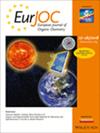基于富勒烯的硒糖球
IF 2.7
3区 化学
Q2 CHEMISTRY, ORGANIC
引用次数: 0
摘要
与硒糖基团功能化的富勒烯由于其重要的性质而受到特别关注,因为一个片段增强了另一个片段的性质。硒糖不仅是增溶基团,而且其固有的生物学特性也为缀合物提供了额外的吸引力。本文报道了一种以12个Th对称结构的硒- d -塔利醇基团修饰的富勒烯六加合物的合成,该六加合物可以由[60]富勒烯的六加合物通过环加成反应和随后的铜催化叠氮化炔烃环加成键化学制备而成。这个被称为硒糖球(SeB)的大型系统已经通过1H NMR和13C NMR光谱、质谱、紫外光谱和动态光散射(DLS)进行了表征。使用多层DFT‐B3LYP‐D3(BJ)/ 6-311 G(2 d,p)//PM7方法进行理论计算,以预测化合物的最稳定构象,并确定控制该分子几何形状的因素。此外,还估计了一些理化参数。此外,这种新化合物在人角质细胞HaCaT细胞上进行了测试,以确定其细胞毒性和潜在的应用前景。本文章由计算机程序翻译,如有差异,请以英文原文为准。
A Fullerene‐Based Selenosugar Ball
Fullerenes functionalized with selenosugar moieties are of particular interest because of their important properties, as one fragment enhances the properties of the other. Selenosugars are not only solubilizing groups, but their intrinsic biological properties also provide additional attractive features to the conjugates. Here the synthesis is reported of a fullerene hexakis‐adduct decorated with 12 peripheral seleno‐d‐talitol moieties with a Th‐symmetric structure, which can be efficiently synthesized from the hexakis‐adduct of [60]fullerene prepared via a cycloaddition reaction and subsequent copper‐catalyzed azide‐alkyne cycloaddition click chemistry. This large‐scale system, refer to as the selenosugar ball (SeB), has been characterized by 1H NMR and 13C NMR spectroscopy, mass spectrometry, UV‐spectroscopy, and dynamic light scattering (DLS). Theoretical calculations using the multilevel DFT‐B3LYP‐D3(BJ)/6–311 G(2 d,p)//PM7 methodology are performed to predict the most stable conformation for the compound and to determine the factors that control the geometry of this molecule. In addition, some physicochemical parameters are estimated. Also, this new compound is tested on human keratinocyte HaCaT cells to determine its cytotoxicity and potential applications.
求助全文
通过发布文献求助,成功后即可免费获取论文全文。
去求助
来源期刊
CiteScore
5.40
自引率
3.60%
发文量
752
审稿时长
1 months
期刊介绍:
The European Journal of Organic Chemistry (2019 ISI Impact Factor 2.889) publishes Full Papers, Communications, and Minireviews from the entire spectrum of synthetic organic, bioorganic and physical-organic chemistry. It is published on behalf of Chemistry Europe, an association of 16 European chemical societies.
The following journals have been merged to form two leading journals, the European Journal of Organic Chemistry and the European Journal of Inorganic Chemistry:
Liebigs Annalen
Bulletin des Sociétés Chimiques Belges
Bulletin de la Société Chimique de France
Gazzetta Chimica Italiana
Recueil des Travaux Chimiques des Pays-Bas
Anales de Química
Chimika Chronika
Revista Portuguesa de Química
ACH—Models in Chemistry
Polish Journal of Chemistry.

 求助内容:
求助内容: 应助结果提醒方式:
应助结果提醒方式:


